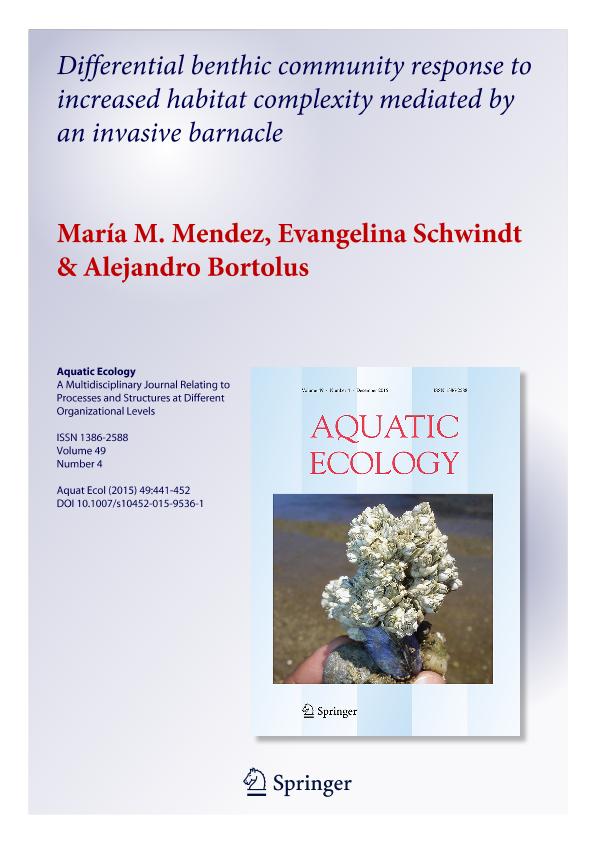Artículo
Differential benthic community response to increased habitat complexity mediated by an invasive barnacle
Fecha de publicación:
12/2015
Editorial:
Springer
Revista:
Aquatic Ecology
ISSN:
1386-2588
Idioma:
Inglés
Tipo de recurso:
Artículo publicado
Clasificación temática:
Resumen
Invasive species threaten native ecosystems worldwide. However, these species can interact positively with local communities, increasing their richness, or the abundance of some species. Many invasive species are capable of influencing the habitat itself, by ameliorating physical stress and facilitating the colonization and survival of other organisms. Barnacles are common engineer species that can change the physical structure of the environment, its complexity, and heterogeneity through their own structure. Balanus glandula is a native barnacle of the rocky shores of the west coast of North America. In Argentina, this invasive species not only colonizes rocky shores but it also has successfully colonized soft-bottom salt marshes, where hard substrata are a limiting resource. In these environments, barnacles form three-dimensional structures that increase the structural complexity of the invaded salt marshes. In this work, we compared the composition, density, richness, and diversity of the macroinvertebrate assemblages associated with habitats of different structural complexity in two Patagonian salt marshes where B. glandula is well established. Our results showed differences in the relative distribution and abundances of the invertebrate species between habitats of different complexities. Furthermore, the response of the communities to the changes in the structural complexity generated by B. glandula was different in the two marshes studied. This highlights the fact that B. glandula facilitates other invertebrates and affect community structure, mainly where the settlement substrata (Spartina vs. mussels) are not functionally similar to the barnacle. Thus, our work shows that the rocky shore B. glandula is currently a critical structuring component of the native invertebrate community of soft-bottom environments where this species was introduced along the coast of southern South America.
Archivos asociados
Licencia
Identificadores
Colecciones
Articulos(CCT-CENPAT)
Articulos de CTRO.CIENTIFICO TECNOL.CONICET - CENPAT
Articulos de CTRO.CIENTIFICO TECNOL.CONICET - CENPAT
Articulos(IBIOMAR)
Articulos de INSTITUTO DE BIOLOGIA DE ORGANISMOS MARINOS
Articulos de INSTITUTO DE BIOLOGIA DE ORGANISMOS MARINOS
Articulos(IPEEC)
Articulos de INSTITUTO PATAGONICO PARA EL ESTUDIO DE LOS ECOSISTEMAS CONTINENTALES
Articulos de INSTITUTO PATAGONICO PARA EL ESTUDIO DE LOS ECOSISTEMAS CONTINENTALES
Citación
Mendez, María Martha; Schwindt, Evangelina; Bortolus, Alejandro; Differential benthic community response to increased habitat complexity mediated by an invasive barnacle; Springer; Aquatic Ecology; 49; 4; 12-2015; 441-452
Compartir
Altmétricas




